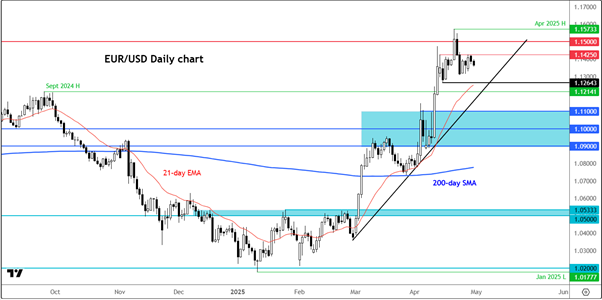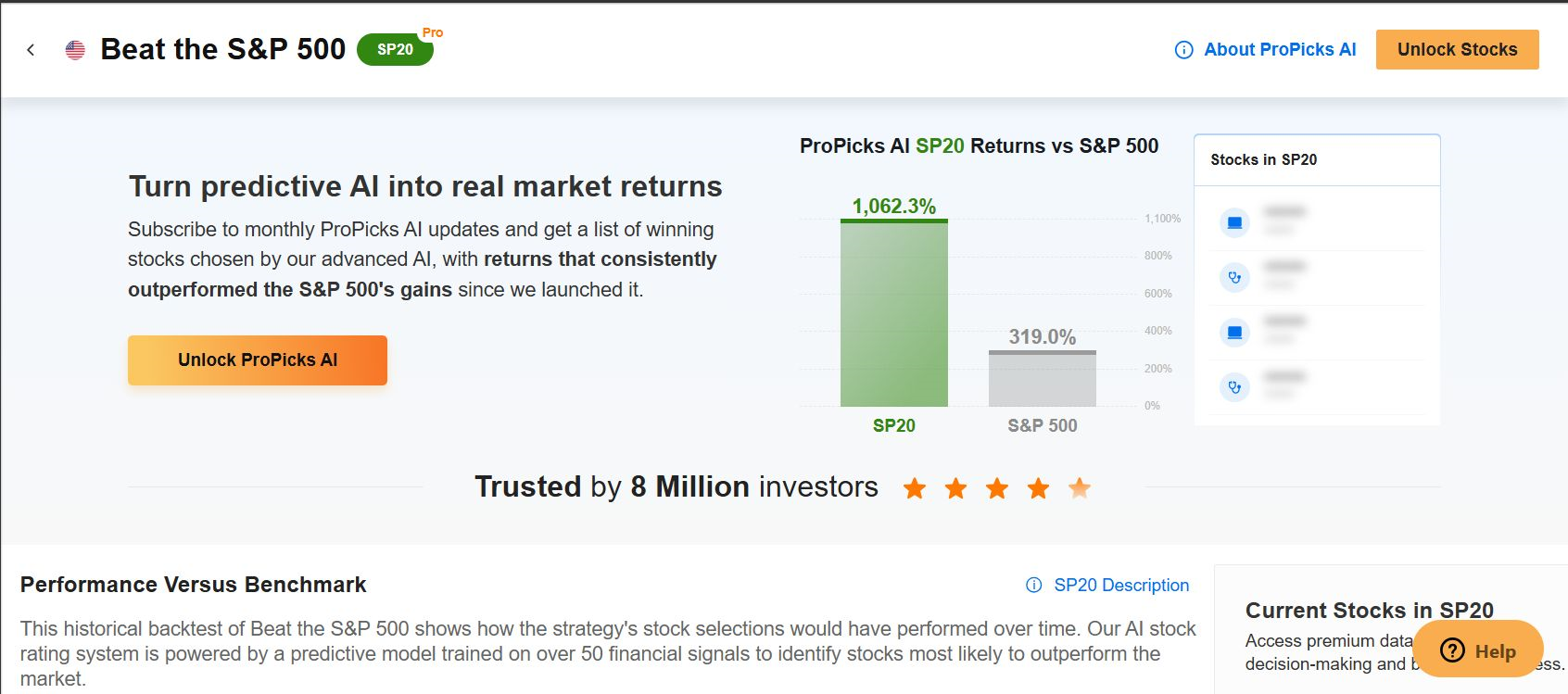Qantas shares slide to 6-mth low as airline trims revenue outlook
-
EUR/USD slips despite Eurozone GDP beat as traders eye softer US data with muted reaction.
-
Strong dollar resilience hints at a shift away from “Sell America” amid trade optimism.
-
With equity markets steering FX, key US data could bring the pair into clear direction.
- Looking for actionable trade ideas to navigate the current market volatility? Subscribe here to unlock access to InvestingPro’s AI-selected stock winners.
We saw stronger-than-expected Eurozone GDP figures this morning, but there was no corresponding rally in the EUR/USD. Traders in the pair also ignored yesterday’s release of soft US data highlighting crushed confidence amid trade uncertainty, raising concerns about US consumer spending. It looks like the resilience of the US dollar to weak data is due to traders reversing the “Sell America” trades, buoyed by renewed optimism around potential trade deals between the US and major partners.
While it is too soon to declare an end to the dollar’s bearish trend, could this be the early stages of a broader dollar rebound? Attention will turn to US GDP report, especially on the consumer spending aspect of it later today.
However, judging by yesterday’s price action to data that would have otherwise crushed the dollar, it is all about the equity markets providing direction for FX right now, with the recent stabilisation amid Trump’s softer tariff tone helping to soothe investor nerves and in doing so, counter negative data flow for the dollar.
Eurozone GDP Beats but EUR/USD Falls Anyway
At 0.4% quarter-over-quarter, the Eurozone economy grew twice more than consensus forecasts. Yet, the EUR/USD refused to climb back above the 1.14 handle. On a country level, Spain’s GDP led with a 0.6% increase, and Germany saw a 0.2% growth to avoid a technical recession.
Yet stagflation concerns remain for much of the Eurozone, and it remains to be seen how much of a boost the bloc will get from all the stimulus measures approved a couple of months ago to combat the impact of US tariffs. Therefore, it is hard to imagine these pre-tariff GDP figures shifting the dial much for the euro.
Markets appear thoroughly convinced by the ECB’s dovish messaging, and it would likely take a notably stronger-than-expected series of data to move the needle. The ECB’s rather untroubled stance on price pressures and the euro’s recent firmness, which offers a degree of insulation to imported inflation, means any short-term strength in Eurozone inflation will not trouble Christine Lagarde or her Governing Council colleagues.
Meanwhile, there is another factor behind the small weakness in the EUR/USD. The recent improvement in risk appetite has caused some unwinding of the “sell America” trade. This has allowed the US dollar to rebound slightly, resulting in some mild selling pressure in the euro. While the EUR/USD trend is far from bearish, the loss of strong bullish momentum points to a period of consolidation or a bit of retracement.
So, What’s Next (LON:NXT) for EUR/USD This Week?
While trade talks will undoubtedly dominate the headlines, a wave of US economic data is set to draw some attention—particularly in light of its potential to sway the timing of the Federal Reserve’s next policy move. For the moment, markets appear to be in consolidation mode, giving off the distinct impression of a calm before the inevitable storm.
All told, it’s shaping up to be a particularly eventful week, with a packed calendar of economic releases, company earnings, continued wrangling over tariffs, and geopolitical flashpoints all jostling for market attention.
GDP Among Key US Data Coming Up
This week’s key US data highlights include ISM PMI surveys, Core PCE index, first-quarter GDP, and the critical US nonfarm payrolls. Among these economic data highlights, GDP and the Core PCE index, both due later today, and nonfarm payrolls report on Friday, could have the biggest influence on the direction of the US Dollar Index and that of the EUR/USD.
All eyes today will be firmly fixed on the first-quarter US GDP figures. Forecasts have been reined in following yesterday’s unexpectedly large goods trade deficit for March, with consensus now pointing to a -0.1% quarter-on-quarter annualised reading. Also on the docket are the ADP employment figures for April and the all-important core PCE reading for March—the Fed’s preferred inflation gauge.
Expectations there are for a soft 0.1% month-on-month print, which may offer some reassurance to more dovish Fed voices and give further legs to rate cut bets for June. Following a barrage of criticism and name-calling from President Trump, the Federal Reserve Chair finds himself under renewed pressure to deliver a rate cut—particularly if core PCE prints on the softer side. Conversely, a stronger-than-expected reading could fan the flames of stagflation concerns, which are already simmering beneath the surface.
All told, the data may lean negative overall, but markets appear to be taking comfort in President Trump’s efforts to mitigate tariff pressures. Still, in my view, a sustained rally in risk assets and the greenback will require more substantive, positive developments on the US-China trade front. For now, though, that may be just enough to keep risk ticking over until Friday’s payrolls.
EUR/USD: Key Levels to Watch

From a technical standpoint, one could argue the EUR/USD forecast is beginning to tilt slightly towards a more neutral-to-bearish bias, following what’s been a rather solid upward move of late. Momentum appears to be waning, particularly after the pair failed to convincingly break through the 1.15 level—largely due to improved risk sentiment and some unwinding of the recent “Sell America” positioning. That said, there’s little in the way of firm evidence to suggest a trend reversal just yet, so a level-by-level approach remains the prudent way forward until directional clarity returns.
Looking at the charts, key support now resides in the 1.1095 to 1.1210 region—marked in blue—which served as the final resistance zone before the recent breakout. Should the pair pull back into this area, we’ll be on the lookout for signs of a tradable bounce, as this zone could well act as a springboard for renewed buying interest.
Closer in, however, there are a few short-term levels worth keeping on the radar. The 1.1300 handle and the September peak at 1.1214 may also offer some interim support before the lower zone comes into play.
As for resistance, 1.1425 remains a near-term hurdle, with the 1.1500 barrier standing as the next major level and then this month’s high at 1.1573 comes into focus.
***
Be sure to check out InvestingPro to stay in sync with the market trend and what it means for your trading. Whether you’re a novice investor or a seasoned trader, leveraging InvestingPro can unlock a world of investment opportunities while minimizing risks amid the challenging market backdrop.
Subscribe now and instantly unlock access to several market-beating features, including:
- ProPicks AI: AI-selected stock winners with a proven track record.
- InvestingPro Fair Value: Instantly find out if a stock is underpriced or overvalued.
- Advanced Stock Screener: Search for the best stocks based on hundreds of selected filters and criteria.
- Top Ideas: See what stocks billionaire investors such as Warren Buffett, Michael Burry, and George Soros are buying.

Disclaimer: This article is written for informational purposes only; it does not constitute a solicitation, offer, advice, counsel or recommendation to invest as such it is not intended to incentivize the purchase of assets in any way. I would like to remind you that any type of asset, is evaluated from multiple perspectives and is highly risky and therefore, any investment decision and the associated risk remains with the investor.
